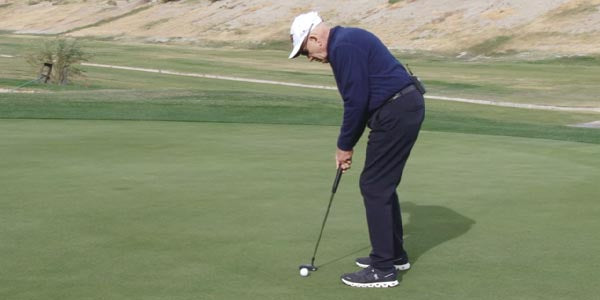Free home try-on available! No upfront payment, free & easy returns
Free home try-on available! No upfront payment, free & easy returns
Product Features
EXPLORE THE LEARNING CENTER
Insights from "The Putt Doctor": A Guide to Improve Your Putting
by Popticals 6 min read
Inside this Article:
In golf, putting stands out as a skill demanding meticulous strategy and precision. Putting requires a deep understanding of reading slopes, assessing the grade (whether it's uphill or downhill), and calculating the speed of the green. Success on the green relies heavily on thorough preparation and analysis, where success begins well before the putter makes contact with the ball.
Dr. Craig Farnsworth, a distinguished Sports Vision Optometrist and leading putting instructor, recently shared valuable insights on critical considerations players should embrace when preparing for a putt.
Who is Dr. Craig Farnsworth
Dr. Farnsworth, renowned for refining the putting skills of some of the world's most talented golfers, continues to make a lasting impact at every level of the golf world. His reputation as one of the best in his field is underscored by his significant contributions to the performance of more than 150 professionals on major tours such as the PGA Tour, LPGA Tour, and European Tour.
Beyond the glamorous stages of professional golf, Dr. Farnsworth dedicates his time to shaping the putting techniques of collegiate players, elite juniors, and recreational golfers.
Dr. Farnsworth distinguishes himself through a unique approach that seamlessly combines his profound understanding of visual acuity from his optometry background with putting mechanics and techniques. This holistic method tackles the physical aspects of putting and integrates the crucial role of vision in attaining peak performance on the greens. Here are some of his insights.
Things to Consider Before Hitting a Putt
When planning a putt, it's crucial to consider various factors to enhance your green-reading routine. Here are six key points to keep in mind:
-
Grade up or down: Assess whether the terrain is sloping upward or downward. Understanding the grade helps players determine proper speed.
-
Length: Take into account the distance of the putt. The length of the putt influences the force and precision needed to reach the cup accurately. Length can also be mixed in with grade as a thirty-foot flat putt will play much shorter than a thirty-foot putt uphill.
-
Break, left to right or right to left: Determine the direction of the break, whether it slopes from left to right or right to left. According to Dr. Farnsworth, misreading the break is the number one reason players miss putts.
-
Amount of break, big breaking putt, or subtle break: Evaluate the extent of the break in the putt. This insight aids in gauging the necessary adjustments for an accurate stroke. Additionally, this helps players react to certain tendencies of golfers overplaying subtle breaking putts and under-reading large breaking putts.
-
Slope consistency: Analyze what happens between the ball and the cup. Identify if the slope is consistent throughout the putt or if there are distinct sections with varying slopes or grades.
-
Geometric kick point: For putts with a significant break, identify the geometric kick point or the point of maximum break. Knowing this allows the player to choose a spot that they need to get the ball to and then have it turn to the hole from there.
Considering these factors collectively as part of a green reading routine enhances the player’s ability to read the green accurately and make informed decisions when executing your putt.
Crafting the Perfect Routine on the Greens
A fundamentally sound putting stroke and a golfer’s ability to control their distance on the green are very important factors to success on the greens but according to Dr. Farnsworth:
In its most simplistic form, green reading is simply the planning that a player undertakes before putting. It is important to craft a proper routine for this planning process to ensure a consistent and comprehensive approach to the way a player reads the greens.
Planning for Length and Uphill/Downhill Grade
Regarding the first two points above, the grade and length of the putt, Dr. Farnsworth recommends the following:
To evaluate these two factors, players should leave their ball on the green and take a look from a side view, starting by looking at the hole and tracing the ground back to their ball.
The side view works best when accessing length and grade because viewing these two things from directly behind the ball, as most players do, can affect perception and does not always provide a visually correct picture of what is going on.”
Planning for Break - The Biggest Challenge of Putting
Once the player has accessed the length of their putt and its uphill or downhill grade, it is time for them to assess what direction their putt is going to break and by how much.
Subtle Breaking Putts
Determining the direction of the break may seem obvious on many greens, but often players misread or don’t see the subtleties of breaks. One method to ensure the right interpretation of a break, according to Dr. Farnsworth, is as follows:
In addition to this method for determining break, it is also important for players to remember that most golfers tend to play too much break on straight subtle putts according to Dr. Farnsworth. They should keep this in mind when choosing their start line.
Large Breaking Putts
While some breaks are subtle, others, which visibly show larger breaks, may appear more recognizable. According to Dr. Farnsworth, most players do not play these obvious breaking putts high enough and tend to miss them on the low side.
Most players, no matter the skill level will not read this much into a ten-foot putt on a green that doesn’t appear to be severely sloped. The main reason is that most golfers tend to only read the last few feet of their putts when in reality, the point of maximum break happens in the middle, also known as the geometric kick point.
A measure that players can build into their routine and practice is picking where they think the geometric kick point–or point of maximum break occurs. On large breaking putts, golfers should try to find this point while looking from behind the ball or hole. The objective then is to get the putt to the geometric kick point such that it gets to that point with sufficient speed but then slows at it with sufficient speed, and then slows as it makes its way to the hole.
Small Breaking Putts
While golfers can underestimate the break on long-breaking putts, they can have the reciprocal tendency to overestimate the break on shorter putts. They should deploy a similar routine to determine the likely break on these putts, remembering that even a five-foot putt can break as much as six inches but being mindful that many may not break at all.
Key Takeaways
Dr. Farnsworth's Expertise
Renowned Sports Vision Optometrist Dr. Craig Farnsworth has made a significant impact on the putting skills of golfers at every level, from tour pros to younger players. His holistic approach combines visual acuity with putting mechanics.
Factors to Consider Before Putting
Dr. Farnsworth outlines six key considerations for effective green reading, including assessing uphill or downhill grade, considering putt length, identifying break direction and amount, analyzing slope consistency, and determining the geometric kick point.
Crafting a Perfect Putting Routine
Dr. Farnsworth emphasizes that a fundamentally sound putting stroke and distance control are crucial, but green reading is the primary reason players make or miss putts. Crafting a proper routine for planning, especially regarding length, uphill/downhill grade, and break-ensures consistency and completeness in green reading.
Side View Technique
Dr. Farnsworth recommends a side view technique for assessing putt length and grade, emphasizing that looking only directly behind the ball may distort perception. This method provides a visually correct picture for players to get a true understanding of what is happening on the green.
Challenges of Reading Break
Assessing the direction and amount of break is a significant challenge. On large breaking putts, identifying the geometric kick point is crucial for successful execution, emphasizing the need to read the entire putt rather than just the last few feet.
For shorter putts, players should engage the same routing they do with long-breaking putts, but be mindful of the golfers’ tendency to overestimate the break of these putts.
Also in NYDEF® Golf

Common Mistakes in Green Reading and Tips to Improve
by Popticals 5 min read

Essential Golf Tips and Techniques: The Journey to the Green
by Popticals 6 min read

The Benefits of Wearing Sunglasses While Playing Golf
by Popticals 5 min read
The Starter
On the Course
Securely pay for what you keep, & simply return the rest.


































